How to Make Raw Sauerkraut and Fermented Vegetables
Raw sauerkraut and other fermented vegetables are rich in probiotics and natural enzymes to restore gut health. Learn how to make this healthy and easy restorative food at home.
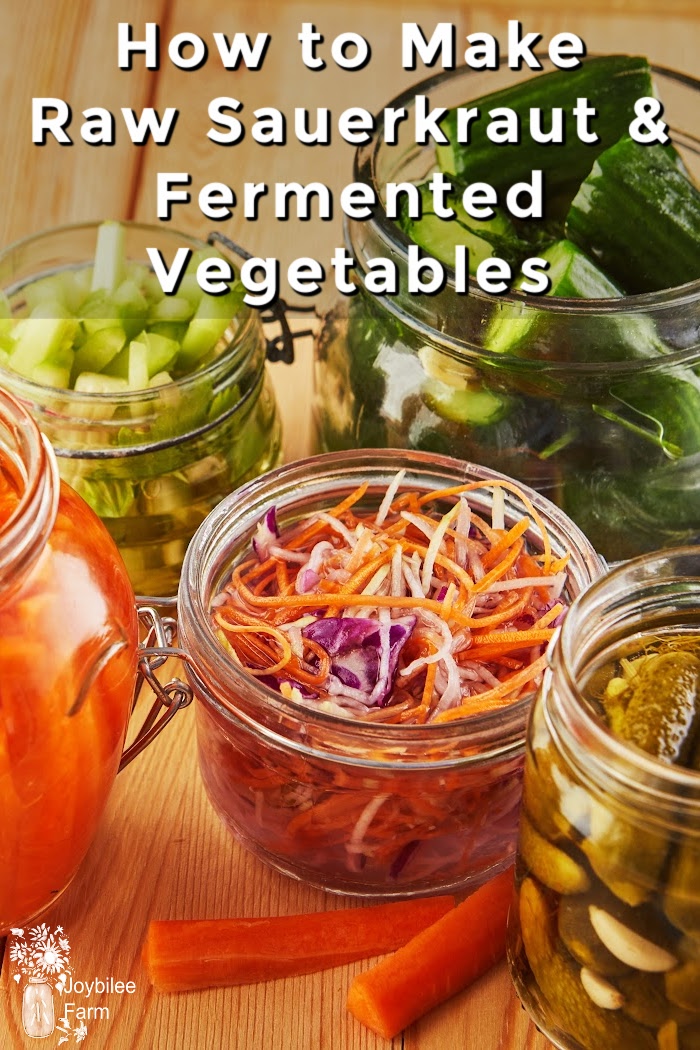
Raw sauerkraut is the iconic fermented vegetable, rich in probiotics and natural enzymes, it is a premium food to restore gut health. Other fermented vegetables like kimchi, fermented carrots, and kosher dill pickles are also important restorative foods.
Every culture has a version of fermented food. From kimchi to yogurt, wine to kombucha, fruits, beverages, sourdough bread, and fermented vegetables stay safe, without refrigeration because of the good bacteria introduced by a starter culture. Before modern sterile food preservation methods, food was preserved by culturing with a starter to increase its nutritional benefits. Fermented food brings more than just increased nutrition to your diet though; it also protects against pathogens and helps digestion. Eating fermented foods can help you lose weight, lower blood pressure, heal your gut, lift depression, clear your mind, prevent cancer, and lose weight

Sauerkraut, Kimchi, pickles, and kombucha protect the stomach from harmful bacteria and viruses by introducing lactic acid, acetic acid, and helpful bacteria to colonize the stomach and prevent bad bacteria and viruses from proliferating. Some people even report being able to stave off the puking and diarrhea of the Norwalk virus by taking a tablespoon full of fermented vegetable juice at the first sign of symptoms.
But the fermented food needs to have a live and active bacterial culture to be effective. Canned and sterilized, or pasteurized sauerkraut or conventional pickles are done in vinegar, which isn’t going to help with harmful bacteria. They also won’t offer you the protective health benefits of raw fermented vegetables. Instead, you need to have live and preferably homemade versions of these simple traditional raw foods.
Culturing your vegetables at home is quick and easy. You can have the jar fermenting on your kitchen counter in less than 15 minutes of prep time and have fermented veggies ready to eat in as little as 5 days. But if you don`t have any cultured vegetables in your fridge, where do you begin?
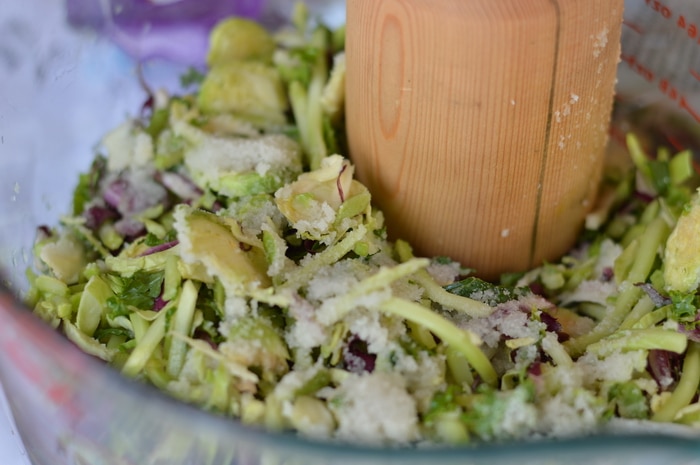
Fermented Vegetables for the raw beginner
- You’ll need a few tablespoons of coarse sea salt, Celtic salt, or Himalayan salt – don’t use conventional table salt.
- Fresh organic vegetables such as cabbage, oriental radishes, cucumbers, carrots, beets, kohlrabi, bok choy, or green beans.
- Spicey vegetables such as ginger, garlic, onion, turmeric, hot peppers, or horseradish (optional)
- Whey with live culture or a starter from another batch. Whey can come from cheese making, or you can drain a container of yogurt and save the whey drippings that separate. You’ll need 2 tablespoons of culture. Using whey or a starter means you can half the salt in the recipe.
- A 1 quart wide mouth mason jar
- A Fermentools kit or another Fermentation Vapor lock
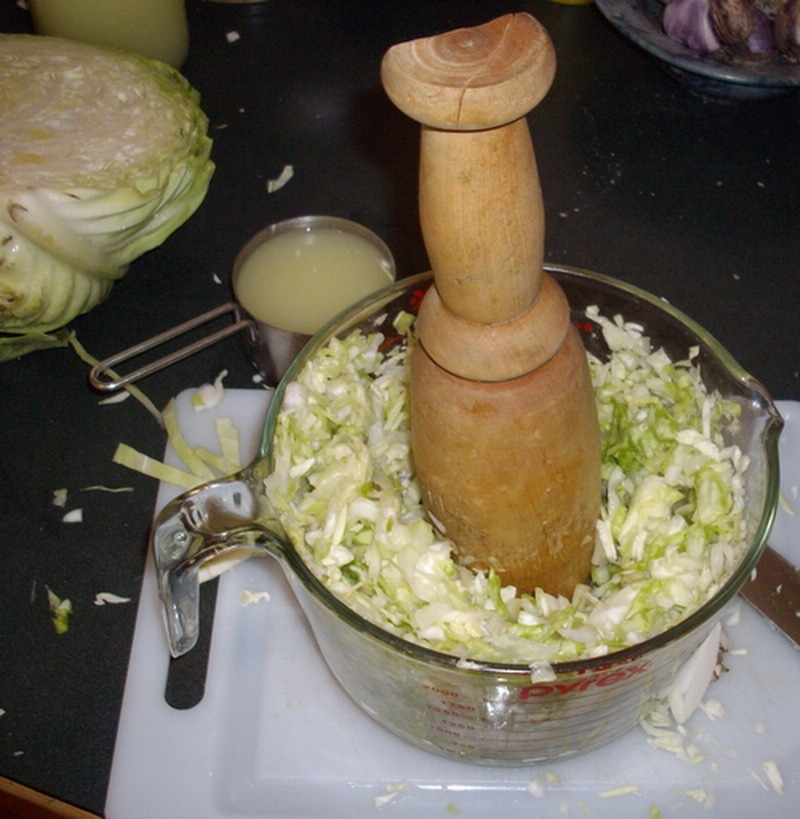
Prepare the Vegetables
Prepare 4 to 6 cups of vegetables. Slice your choice of vegetables thinly. Add any spicey vegetables that you like by shredding, slicing thinly, or grating. Mix the vegetables. Add 2 tablespoons of sea salt per quart of vegetables.
If you are using hard vegetables like cabbage or carrots pound the vegetables with a kraut pounder to release the juice and bruise the tissue. This speeds up the fermentation process as well as releasing the natural bacteria on the outside of the cabbage, to promote fermentation.
Set aside
Sterilize the mason jar.
Add 2 tablespoons of whey, or starter from another batch of fermented vegetables.
Add additional filtered water if necessary to keep the vegetables submerged in the brine.
Place the glass fermentation weight from the Fermentools kit
If you don’t have a glass weight, add a cabbage leaf, or a plastic lid cut to fit the shoulders of the jar. This will keep the vegetables under the brine and prevent mold.
Fill the wine vapour lock cap ½ full of sterilized and cooled water. Put the vapour lock on the jar and wait for 4 to 8 hours. The correct lacto-bacteria grows in an anaerobic environment, so you want to exclude as much oxygen as possible. Leave the jar on your kitchen counter so that you can watch it.
The fermented vegetables will release liquid because of the salt. Fine bubbles will begin to form on the outside of the cut vegetables, inside the jar. The vegetables will begin to rise in the jar. Once this happens you know that the process is working.
If the liquid in the jar seeps out of the lid, simply wipe with a clean paper towel to absorb the excess liquid. The process will be active for 4 or 5 days and then stop abruptly. At this point your fermented vegetables are finished. Remove the glass weight. Replace the vapour lock with a normal lid that fits the jar.
You can store the jar in your refrigerator to eat right away or you can store it in a cool dry place, like your root cellar. Fermented vegetables need no further processing. I’ve kept jars of sauerkraut in my fridge for a year and served out of them throughout the year. They are kept preserved by the lacto bacteria in them.

Here are some fermented vegetables to try:
|
Making fermented vegetables add 2 to 4 tsp. sea salt plus ¼ cup starter culture, per 8 cups of prepared vegetables |
Spicy additions (optional) |
| Grated carrots, grated beets, | thinly sliced onions, grated ginger |
| Shredded cabbage or finely cut kale, Shredded carrots, | thinly sliced onions |
| Thinly sliced bok choy or suey choy, grated daikon radish, or grated red-heart radish or grated turnips | peeled and grated ginger, whole garlic |
| Thinly sliced English or thinly sliced dill cucumbers, (fermented pickles) | whole peeled garlic, one dill flower |
| Diced tomatoes, diced hot peppers, (fermented salsa) | diced onions, crushed garlic, cilantro, finely chopped, coriander seeds |
| Whole green or yellow beans, thinly sliced jalapeno peppers | Crushed garlic, dill flower, |
Are my fermented vegetables safe to eat?
Properly fermented sauerkraut does not smell like a dead body. It has a fresh, clean, slightly sweet, slightly acid smell. If it smells bad or has mold forming on the top of the contents of the jar, don’t eat it. Air got into the jar before the lacto-bacteria had a chance to colonize the jar and protect the food from spoilage. Dump the contents, re-sterilize the jar and lid and try again.
(Note: To sterilize the plastic vapour lock, wash in hot soapy water, rinse well and use vinegar or hydrogen peroxide to sterilize. Rinse well before using.)
Make sure that the liquid in the jar completely submerges the fermented vegetables by the end of the first 24 hours. I like to see a small puddle of liquid on the top of the lid, that has overflowed the airlock. Then I know for sure that the jar has been sealed to prevent oxygen from contaminating the batch. Once the batch is finished fermenting, the contents will shrink back into the jar. When this happens you will know that it’s time to change the lid to a storage lid and move the jar to a cooler place.
Fermented vegetables add another level of nutrition to your food security. They offer vitamin C in winter, and protection from viruses and illness, too. The Brits used to take sauerkraut on their long sea journeys to prevent scurvy, until limes, which are easier to transport, became more readily available. Fermented vegetables are a really good survival food, and the base – cabbage family plants – are easy to grow in most environments. We can even grow Kale in our area that gets year-round frost.
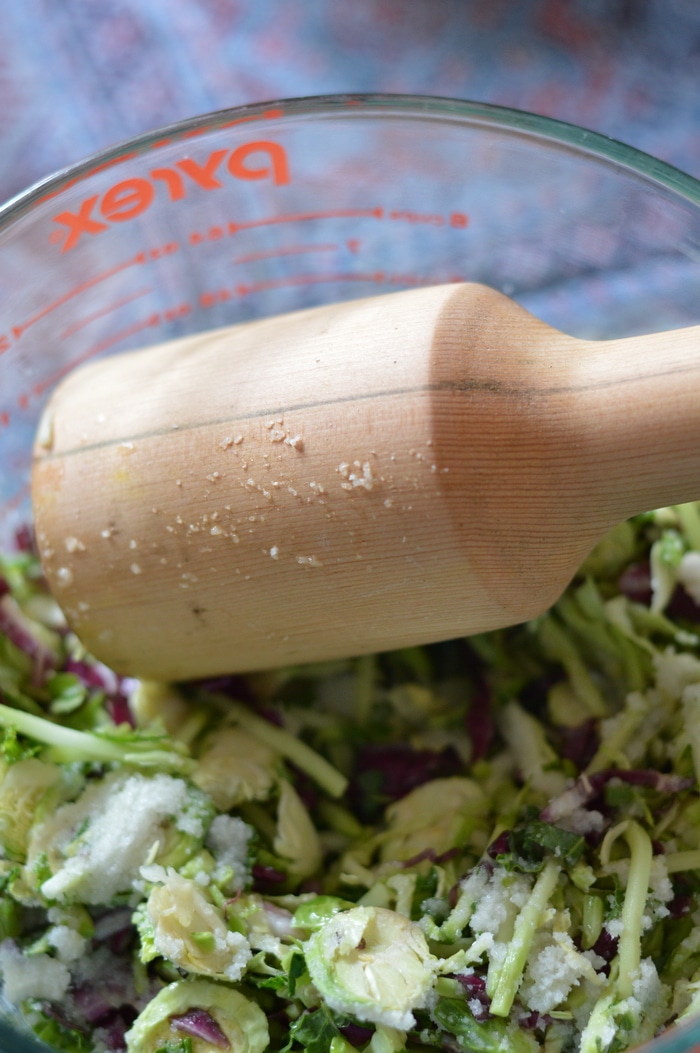
Start eating fermented vegetables slowly
If you have never eaten sauerkraut or kimchi, start slowly with just a tablespoon added to your lunch menu. Let your stomach get used to the new food over a couple of weeks, otherwise, you may have gas, bloating, and flatulence as your body adjusts. If you’ve had a diet of processed foods, which are high in genetically modified ingredients, eating fermented vegetables will restore your stomach and your brain health, as you bring them into your diet slowly.
Lacto fermented foods also help with your weight loss goals by balancing your blood sugar and correcting insulin resistance.
I hope this gives you the confidence to try adding raw, fermented vegetables to your kitchen repertoire. You aren’t stuck with sauerkraut or pickles if your family detests these kinds of foods. Fermented salsa, fermented carrots, and even fermented mustards are good lacto fermented additions and contain many of the same benefits that your family needs to stay healthy year-round. Fermented vegetables are one of the four pillars to healing many health issues that begin with unhealthy food choices and lead to chronic stomach issues.
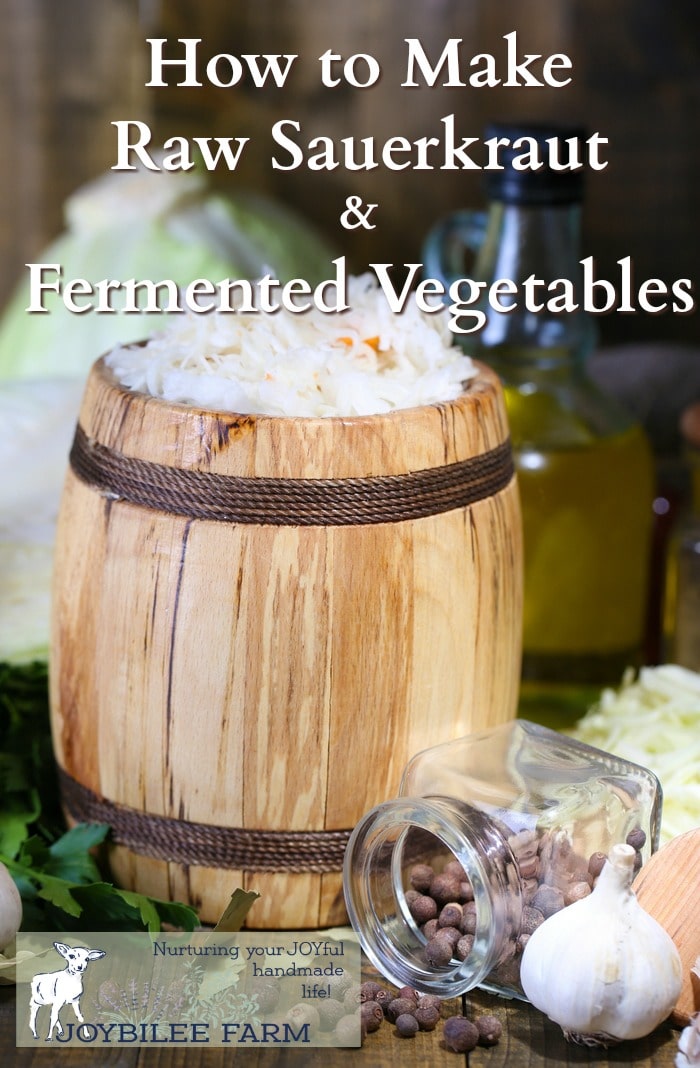
Your turn:
Could adding raw sauerkraut or other fermented vegetables make a difference in how you feel each day? Let me know in the comments what’s keeping you from adding this wonderful superfood to your daily menu?



I started fermenting in 2022 and went with a “starter kit” from Amazon ($30). I loved the results, and wanted more jar space. At first look, supplies were too expensive for my budget as well. However; I got a couple of 1-quart, wide-mouth Ball (mason) jars for $10.75 USD. Those are a standard, so there are a lot of secondary manufacturers making things that fit the wide mouth. I wanted to get more air-lock lids, but they too were expensive. But looking at many offerings on Amazon, I found a set of 4 silicon fermenting lids that fit snugly into the wide mouth for $11.74. They have a small X-slit on the top, and work perfectly. Extra liquids and gas push through the flexible “X” which collapses back to flat again, making it pretty airtight.
I wanted glass weights, and after a lot of scrolling, found a company (Elementi) that makes a 4-pack at a very affordable price — $11.89 USD. I have a dough rolling pin, solid birch with no handles. The end fits nicely into the Ball jar, and acts as a compactor and crusher. All in all, I now have 2 quart jars, 2 pint jars, and 4 weights, along with 4 silicon fermenting lids. The pint jars also are standard wide mouth. Everything fits. The Ball jars were the most expensive: $10.75 for 2.
I also learned that if something fits in a glass jar with a lid, that works. I use a cleaned Vlassic pickle jar to make our own fermented Kosher pickles. I just loosen the lid each day at the start, enough to let gas out. People used to just throw food into an old barrel on the farms, with some salt. It’s an ancient process, much older than airlock lids, mason jars, and so forth.
If you reconstitute the dried veges using filtered water I can see no reason why using these veges wouldn’t achieve the same result of fermentation can’t see a problem Judi. The only stumbling block might be if in the original drying process you added other substances, preservatives and the like. 🙂
could you also do an article on fermented fruits. Are the health benefits the same as with vegetables?
This is a great recipe for beginners! I love that you went through every step of the process and even included pictures for every step of the way. That is so helpful especially for visual learners. Thank you for sharing!